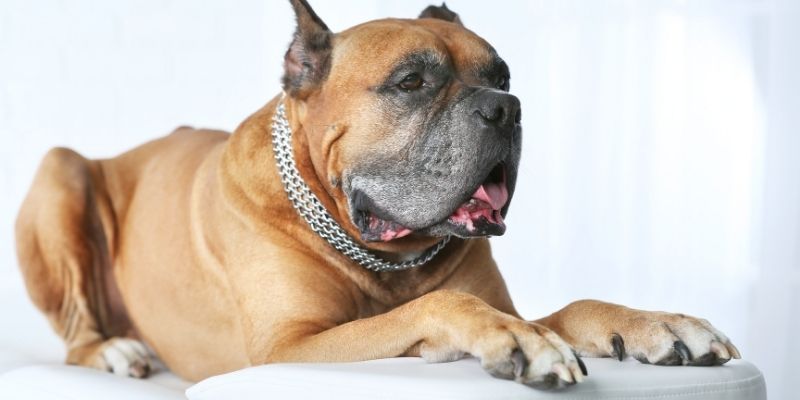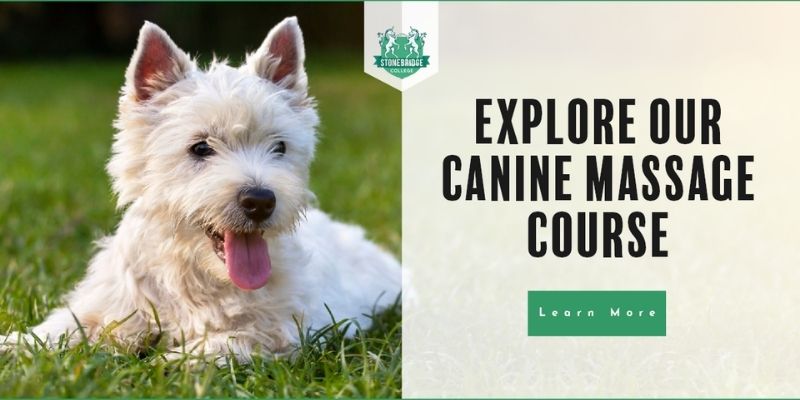
If you, like millions of other people, have an almost uncontrollable adoration for dogs, why not consider a career where you can help them get back to their best selves?
There are so many ailments a dog can have that can cause them physical discomfort or dampen their spirit. With a practised and informed touch, a Canine Massage Therapist can target the problem areas and address any soft tissue problems the dog may have.
For this reason, canine massage therapy has quickly become recognised as an important natural healing therapy for dogs. It allows the person performing the massage to provide hands-on help to an animal they adore, and it can bring a new lease of life into the canine as their problems are alleviated.
As a relatively new form of canine care, you probably still have several questions surrounding this career choice. To help, we have answered the most frequently asked below.
What is Canine Massage Therapy?
This form of canine therapy is non-invasive and uses the power of the hands to target muscular issues in dogs. A dog has over 700 muscles that work in unison with its bones to enable movement. As such, when dogs suffer an injury or develop a condition, it’s likely their muscles are going to be affected.
Through skilled muscle manipulation and targeted pressure, canine massage therapy is acutely effective in rehabilitating a range of issues. A Canine Message Therapist switches between four disciplines of massage, within which there are at least 50 different techniques.
These include:
- Myofascial release
- Direct and indirect approach
- Deep tissue
- Remedial sports
- Swedish massage, and more

The Benefits of Canine Massage
There are a host of issues a clinical canine massage can work to improve, helping all manner of dogs from those that are ageing to those who need a little TLC after a hard day’s work.
A few of the issues canine massage therapy can help include:
- Coat and skin conditions
- Injury recovery
- Making dogs more comfortable with being touched
- Neurological disorders
- Orthopaedic issues
- Pain and tension relief for working dogs
- Pain relief for age-related conditions
- Pain relief for hereditary conditions
- Performance enhancement
- Recurrent lameness
- Soft tissue injuries
- Uneven or faulty gait
By attending clinical canine massage therapy sessions, a dog can expect to:
- Be in less pain
- Have heightened mobility
- Regain the ability to be active
- Have lameness, limping or stiffness reduced or eradicated
- Be more open to physical examinations and touch
- Overcome muscular injuries
- Return to normal posture and gait
- Be happier and have an improved mood
What Happens in a Canine Message Session?
There are a number of things a Canine Massage Therapist needs to tick off their list during a clinical canine massage therapy session. While your canine clients have been referred to you by a Veterinarian, there is a lot you need to establish before the hands-on work can get underway.
Once you have met your canine clients and given them an adequate amount of cuddles and kisses, you will need to perform a:
- Gait Analysis
- Postural Analysis
- Superficial Tactual Exploration
- Full Consultation, including a Medical History and Activities of Daily Living (ADL) Assessment
During the session you will also need to:
- Discuss and establish the expectations of the therapy with the dog owner
- Conduct the canine massage therapy session, normally lasting around 45-50 minutes
- Provide full feedback to the owner, often via a visual description
- Issue the owner with a home care plan and discuss and other recommendations
- Advise them to come back for the required number of sessions you believe the dog will need to overcome their issue. This is typically 3 or 4 sessions, but some dogs require less

What Training Do You Need to be a Canine Masseuse?
You don’t technically need to have official qualifications to become a Canine Massage Therapist. However, it’s illegal for anyone but the dog owner to treat a dog unless a Veterinarian has signed off on that treatment.
Vets aren’t going to refer dog owners to someone they don’t think has the skills for the job. So, it’s wise to study clinical canine massage to evidence your knowledge and skills.
There are many canine massage books and workshops you can do to pick up the required skills. However, studying detailed canine massage courses UK, is often the best way to complete the thorough training required to develop a working knowledge of the muscular system.
With Stonebridge Associated Colleges, you can study:
Principles of Canine Massage Diploma
Through this course, you will:
- Understand canine anatomy and physiology
- Study the benefits of canine massage
- Learn about different treatments for common canine issues
- Complete your learning entirely from home
Canine Massage Level 3 Diploma (RQF)
Through this course, you will:
- Gain the knowledge and skills for a successful career in canine massage
- Learn how to effectively handle canines
- Study canine behaviours
- Explore numerous types of massage techniques
- Study the theory from home then practice your new skills in a canine massage environment

Study Canine Massage Courses Online!
By choosing to gain your canine massage therapy education via online courses, you can more easily juggle your course with your existing commitments. This makes retraining as a Canine Massage Therapist much easier, especially if you’re doing so around your current employment or childcare responsibilities.
As one of the leading UK distance learning providers, Stonebridge Associated Colleges has multiple courses in canine care. If clinical canine massage therapy sounds like the career path for you, you can study courses that will kick start your new working life in this area online.
Find out more about the various canine massage courses we offer by talking to our Course Executives today. They can run you through the modules you will cover, the level of tutor support you will receive, and the payment options you can take advantage of.
Call them on 0121 392 8288, contact them online or click below to view the Canine Massage Level 3 Diploma (RQF) in more detail.






Leave a Reply